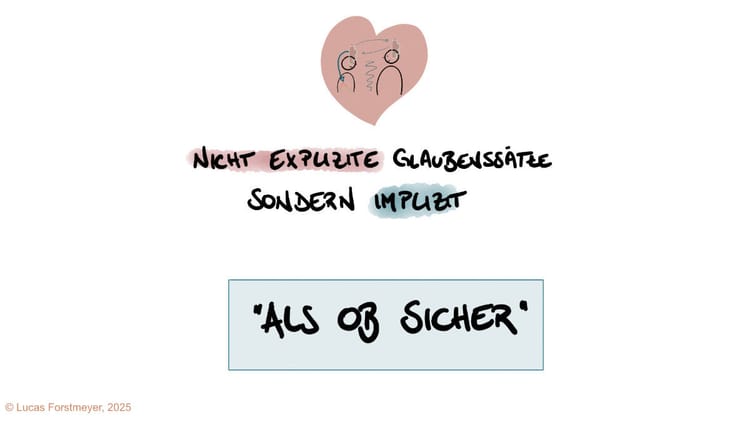3.3: The "As If" Feeling: How Early Experiences Shape Our Implicit Worldview

The repeated attachment experiences of the first two years—the nonverbal dance of brains—leave deep traces. But these traces don’t take the form of conscious beliefs or explicit memories. They shape an implicit "as if" feeling—a deeply embodied stance toward the world that guides our behavior long before we think about it.
The Stable Base: Living "As If" the World Is Safe
When the attachment between parent and child goes well and synchronization occurs often enough, a stable base develops. The child doesn’t consciously learn “The world is good,” but learns to act as if the world were good and safe.
- In contact, it turns toward others with curiosity because it has learned to behave as if contact were safe and nourishing.
- Under stress, it can self-soothe because it has been soothed countless times. It behaves as if stress is tolerable and temporary.
- In conflict, it trusts that connection can be restored afterward. It behaves as if relationships are resilient and worth repairing.
These “as if” orientations form the deepest foundation of resilience and relational capacity. They operate beneath thought and persist into adulthood.
The Unstable Base: Living "As If" the World Is Unsafe
But what happens when early synchronization is missing? The brain still adapts—to the world it experiences. When secure attachment is absent, the child forms an unstable base, learning to behave as if the world were unsafe and dangerous.
- In contact, it might withdraw or constantly monitor the connection because it has learned as if relationships are unsafe.
- Under stress, it may never have learned to calm itself. Instead, it escalates or dissociates—the only survival strategies available.
- In conflict, it feels existential threat, having never experienced that connection can safely return.
This continual need to act as if the world is unsafe is another name for trauma. It’s not a past event but an unintegrated, implicit state still living in the nervous system. Because trauma is stored in body states rather than thoughts, it cannot be resolved through cognition alone.
Our basic sense of safety or unsafety is therefore not a belief we choose but a bodily posture toward life, shaped in the first two years through the quality of our earliest relationships.
Sources
- Iain McGilchrist: The Master and His Emissary
- ****Iain McGilchrist (Buch):****The Matter With Things
- Schore: Affect Regulation and the Origin of the Self (APA) | Buch (1994)
- Schore/Schore: Modern Attachment Theory & Affect Regulation | Studie (2007)
Related Articles
- 3.1: The Unfinished Brain: Why the First Two Years of Life Are Crucial
- 3.4: Healing in Resonance: Why Therapy Must Recreate the Early Parent-Child Relationship
- 4.2: The Miracle of Stability: Why the Body Is a River, Not a Machine
- 2.2: The Silent Thought: How True Insight Arises Before Words
- 5. Glossary: Key Terms of the Needs and Growth Model